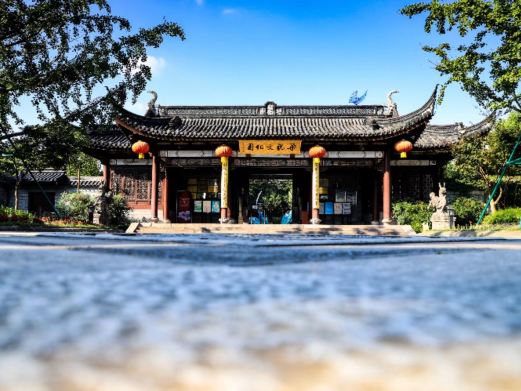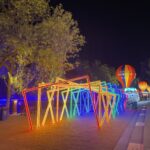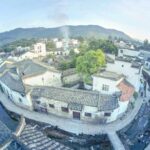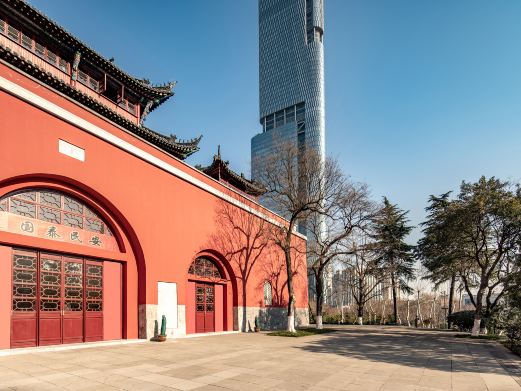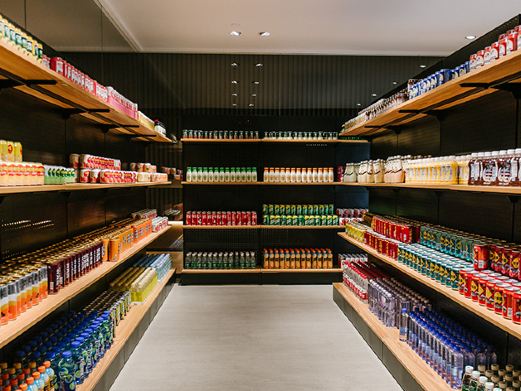The Liang-Zhu Scenic Area is located in the western suburbs of Ningbo. It is a love-themed park with the background of the love story of Liang Shanbo and Zhu Yingtai. It is also the birthplace of the Liang-Zhu story. The park takes the Liang Shanbo Temple as the main body and connects Wansong Academy, Liang Shanbo’s ancient tomb, and Liang-Zhu cultural sculptures with the Liang-Zhu legend. Although most of the buildings in the park are later-built antique buildings and do not have a strong historical atmosphere, the garden sketches with Jiangnan characteristics can also be called exquisite.
Many couples will come here to witness love. Sometimes matchmaking activities are also held in the park. It can be said to be a very romantic place. The park area is not too large and can be visited on foot. To the right of the scenic area entrance, after crossing a small bridge, is the ‘Eighteen Farewells Road’ that runs through the park. Walking along this main road, you can circle the park and reach the exit. When crossing the bridge and encountering a building, it is the Liang-Zhu Love Post Office. There are only two post offices with love as the theme in the country. The other one is in the Summer Palace. As soon as the post office was completed, it became one of the attractions in the park. Similar to the ‘love postmark’ on Shanghai’s Tian’ai Road, you can also stamp a ‘love postmark’ here and send out your love and touch, or buy a ‘love passport’ and stamp it on every anniversary to leave a mark. The post office also provides regular mail delivery services. You can send a love mail on every wedding anniversary. Different commemorative days of different years will also be stamped with different characteristic postmarks. Continuing to walk along the trail, not far away is the Liang-Zhu Academy (Wansong Academy) where Liang Shanbo and Zhu Yingtai studied together for three years. The academy is an ancient building of the Ming and Qing Dynasties. There are plum blossoms planted in the courtyard. Behind the courtyard is a bamboo forest, simple and elegant. The Butterfly Art Museum in it exhibits a large number of butterfly specimens from all over the world and is worth seeing. Then passing through Phoenix Mountain and Guanyin Hall until reaching the Yaojiang River is where Zhu Yingtai’s family courtyard is located. The architecture of Zhu’s Mansion is very imposing and everywhere reveals the temperament of an official and wealthy family. Especially a large bridal sedan chair in the Sixin Hall has relatively complicated pattern carvings. Walking not far in the direction of the exit, you will come to Liang Shanbo’s tomb. The horizontal tablet in front is engraved with ‘The Tomb of Liang Shengjun Shanbo, Bestowed by Imperial Decree’. There is an obvious crack in the middle of the tablet. It is said that it cracked when Zhu Yingtai sacrificed to Liang Shanbo. Behind the tomb is Zhu Yingtai’s tablet. There is a place selling flowers nearby. You can pay as you wish and offer it on the tomb to show your sacrifice. Next to the ancient tomb is the Liang Shanbo Temple, which is also the main building of the park. The entire temple is divided into three sections, namely the mountain gate, the main hall, and the back hall. Entering the mountain gate, the first thing that catches the eye is a ceramic mural of butterflies in love. It depicts the entire story of Liang Shanbo and Zhu Yingtai from swearing brotherhood at the grass bridge to turning into butterflies.In the main hall, there are statues of Liang Shanbo and Zhu Yingtai. This is also a place where people pray for a free and happy marriage. When reaching the square where the Liang-Zhu music fountain is located, in the center of the square is the sculpture of Liang Shanbo and Zhu Yingtai turning into butterflies, which is one of the symbols of the scenic area. You can take photos here. In the adjacent Liang-Zhu Culture Museum, there are exhibitions such as the love tree and reliefs with Liang-Zhu theme to see.
There are also some interactive projects to participate in. If you want to understand the history of Liang-Zhu culture and its influence on folk culture, you may wish to visit here. Opening hours: Open from 08:00 to 17:00 from January 1st to September 30th; open from 08:00 to 22:00 from October 1st to October 31st; open from 08:00 to 17:00 from November 1st to December 31st. Preferential policies: Children: Free for those under 1. 3 meters (excluding 1.3 meters); discounted for those between 1.3 meters (including 1.3 meters) and 1.5 meters (including 1.5 meters). The elderly: Free for those aged 70 or above with senior citizen card or ID card. Military personnel: Free for active-duty military personnel with officer ID card. Disabled people: Free with disability certificate. Service facilities: Parking lot: [Underground parking lot of Liang-Zhu Cultural Town]. Reference price: ¥0/hour. Address: Liang-Zhu Cultural Park, Gaoqiao Town, Yinzhou District. Parking spaces: 400.